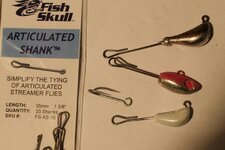Bucho
Member
From the squid to the sculpin to the ragworm - these things got my wheels spinning biiig time! :idea: The steel is flexible enough to thread a propeller and a bead up the shank. The hookeye is an extra eye I once bought for sinkers.
A skilled feather wire bender - who I am not - might of course save himself the money. The shank works best in silicon-modified colarless molds which hold the wire in place while pouring. Otherwise the lead will push it out of the cavity. Or it just drops, either wax.
The shank needs to be tied over in order to secure the hook, so a replacement hook would have to be an open eye seawash for instance. A walleye jig application might use a (shrink) tube to hold the stinger in place. Personly, I like the idea that I can put more value into a lure with exchangeable hooks and a longer life span. I also like the idea of smaller, downpointing hooks for my open water trout fishing.

A skilled feather wire bender - who I am not - might of course save himself the money. The shank works best in silicon-modified colarless molds which hold the wire in place while pouring. Otherwise the lead will push it out of the cavity. Or it just drops, either wax.
The shank needs to be tied over in order to secure the hook, so a replacement hook would have to be an open eye seawash for instance. A walleye jig application might use a (shrink) tube to hold the stinger in place. Personly, I like the idea that I can put more value into a lure with exchangeable hooks and a longer life span. I also like the idea of smaller, downpointing hooks for my open water trout fishing.



